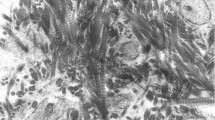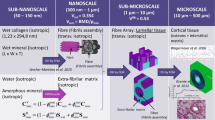Abstract
The woven bone created during the healing of bone regeneration processes is characterized as being extremely inhomogeneous and having a variable stiffness that increases with time. Therefore, it is important to study how the mechanical properties of woven bone are dependent on its microarchitecture and especially on its porosity and mineral content. The porosity and the x-ray greyscale of specimens taken from bone transport studies in sheep were assessed by means of ex vivo imaging. Our study demonstrates that the porosity of the woven bone in the distraction area diminishes during the healing process from 73.3% 35 days after surgery to 31.9% 525 days after surgery. In addition, the woven bone’s porosity is negatively correlated with its Young’s modulus. The x-ray greyscale, was measured as an indicator of the level of mineralization of the woven bone. Greyscale index has been demonstrated to be inversely proportional to porosity and to increase to up to 60–80% of the level in cortical bone. The results of this study may contribute to the development of micromechanical models of woven bone and improvements in in silico modelling.







Similar content being viewed by others
References
Aldieri, A., M. Terzini, G. Osella, A. M. Priola, A. Angeli, A. Veltri, et al. Osteoporotic hip fracture prediction: is T-score based criterion enough? A hip structural analysis based model. J. Biomech. Eng. 2018. https://doi.org/10.1115/1.4040586.
Augat, P., and L. E. Claes. Prediction of fracture load at different skeletal sites by geometric properties of the cortical shell. J. Bone Miner. Res. 11:1356–1363, 1996.
Boccaccio, A., P. J. Prendergast, C. Pappalettere, and D. J. Kelly. Tissue differentiation and bone regeneration in an osteotomized mandible: a computational analysis of the latency period. Med. Biol. Eng. Comput. 46:283–298, 2008.
Brunner, U. H., J. Cordey, L. Schweiberer, and S. M. Perren. Force required for bone segment transport in the treatment of large bone defects using medullary nail fixation. Clin. Orthop. Relat. Res. 301:147–155, 1994.
Burke, D. P., and D. J. Kelly. Substrate stiffness and oxygen as regulators of stem cell differentiation during skeletal tissue regeneration: a mechanobiological model. PLoS ONE 7:e40737, 2012.
Claes, L. E., J. Laule, K. Wenger, G. Suger, U. Liener, and L. Kinzl. The influence of stiffness of the fixator on maturation of callus after segmental transport. J. Bone Jt. Surg. Br. 82:142–148, 2000.
Currey, J. D. The relationship between the stiffness and the mineral content of bone. J. Biomech. 2:477–480, 1969.
Currey, J. D. Changes in the impact energy absorption of bone with age. J. Biomech. 12:459–469, 1979.
Currey, J. D. The effect of porosity and mineral content on the Young’s modulus of elasticity of compact bone. J. Biomech. 21:131–139, 1988.
Currey, J. D. Bones: Structure and Mechanics. Princeton: Princeton University Press, 2002.
Currey, J. D. Incompatible mechanical properties in compact bone. J. Theor. Biol. 231:569–580, 2004.
Currey, J. D., and R. Shahar. Cavities in the compact bone in tetrapods and fish and their effect on mechanical properties. J. Struct. Biol. 183:107–122, 2013.
Dahl, M. T., B. Gulli, and T. Berg. Complications of limb lengthening. A learning curve. Clin. Orthop. Relat. Res. 301:10–18, 1994.
Floerkemeier, T., F. Thorey, C. Hurschler, M. Wellmann, F. Witte, and H. Windhagen. Stiffness of callus tissue during distraction osteogenesis. Orthop. Traumatol. Surg. Res. 96:155–160, 2010.
Fürmetz, J., C. Soo, W. Behrendt, P. H. Thaller, H. Siekmann, J. Böhme, and C. Josten. Bone transport for limb reconstruction following severe tibial fractures. Orthop. Rev. (Pavia) 8(1):6384, 2016.
Gong, J. K., J. S. Arnold, and S. H. Cohn. The density of organic and volatile and non-volatile inorganic components of bone. Anat. Re. 149:319–324, 1964.
Ilizarov, G. A. The tension-stress effect on the genesis and growth of tissues: Part II. The influence of the rate and frequency of distraction. Clin. Orthop. Relat. Res. 239:263–285, 1989.
Ilizarov, G. A. The tension-stress effect on the genesis and growth of tissues. Part I. The influence of stability of fixation and soft-tissue preservation. Clin. Orthop. Relat. Res. 238:249–281, 1989.
Isaksson, H., O. Comas, C. C. van Donkelaar, J. Mediavilla, W. Wilson, R. Huiskes, et al. Bone regeneration during distraction osteogenesis: mechano-regulation by shear strain and fluid velocity. J. Biomech. 40:2002–2011, 2007.
Isaksson, H., C. C. van Donkelaar, R. Huiskes, and K. Ito. A mechano-regulatory bone-healing model incorporating cell-phenotype specific activity. J. Theor. Biol. 252:230–246, 2008.
Lacroix, D., and P. Prendergast. A mechano-regulation model for tissue differentiation during fracture healing: analysis of gap size and loading. J. Biomech. 35:1163–1171, 2002.
Leong, P. L., and E. F. Morgan. Correlations between indentation modulus and mineral density in bone-fracture calluses. Integr. Comp. Biol. 49:59–68, 2009.
López-Pliego, E. M., M. Á. Giráldez-Sánchez, J. Mora-Macías, E. Reina-Romo, and J. Domínguez. Histological evolution of the regenerate during bone transport: an experimental study in sheep. Injury 47(Suppl 3):S7–S14, 2016.
Manjubala, I., Y. Liu, D. R. Epari, P. Roschger, H. Schell, P. Fratzl, et al. Spatial and temporal variations of mechanical properties and mineral content of the external callus during bone healing. Bone 45:185–192, 2009.
Martin, B. Aging and strength of bone as a structural material. Calcif. Tissue Int. 53:S34–S39, 1993.
Martínez-Reina, J., J. García-Rodríguez, J. Mora-Macías, J. Domínguez, and E. Reina-Romo. Comparison of the volumetric composition of lamellar bone and the woven bone of calluses. Proc. Inst. Mech. Eng. H. 232:682–689, 2018.
McCalden, R. W., J. A. McGeough, M. B. Barker, and C. M. Court-Brown. Age-related changes in the tensile properties of cortical bone. The relative importance of changes in porosity, mineralization, and microstructure. J. Bone Jt. Surg. Am. 75:1193–1205, 1993.
Mora-Macías, J., M. A. Giráldez-Sánchez, M. López, J. Domínguez, and E. Reina-Romo. Comparison of methods for assigning the material properties of the distraction callus in computational models. Int. J. Numer. Methods Biomed. Eng. 35(9):e3227, 2019.
Mora-Macías, J., A. Pajares, P. Miranda, J. Domínguez, and E. Reina-Romo. Mechanical characterization via nanoindentation of the woven bone developed during bone transport. J. Mech. Behav. Biomed. Mater. 74:236–244, 2017.
Mora-Macías, J., E. Reina-Romo, and J. Domínguez. Distraction osteogenesis device to estimate the axial stiffness of the callus in vivo. Med. Eng. Phys. 37:969–978, 2015.
Mora-Macías, J., E. Reina-Romo, and J. Domínguez. Model of the distraction callus tissue behavior during bone transport based in experiments in vivo. J. Mech. Behav. Biomed. Mater. 61:419–430, 2016.
Mora-Macías, J., E. Reina-Romo, M. López-Pliego, M. A. Giráldez-Sánchez, and J. Domínguez. In vivo mechanical characterization of the distraction callus during bone consolidation. Ann. Biomed. Eng. 43:2663–2674, 2015.
Mora-Macías, J., E. Reina-Romo, J. Morgaz, and J. Domínguez. In vivo gait analysis during bone transport. Ann. Biomed. Eng. 43:2090–2100, 2015.
Papakostidis, C., M. Bhandari, and P. V. Giannoudis. Distraction osteogenesis in the treatment of long bone defects of the lower limbs: effectiveness, complications and clinical results; a systematic review and meta-analysis. Bone Jt. J. 95-B(12):1673–1680, 2013.
Renders, G. A. P., L. Mulder, L. J. van Ruijven, and T. M. G. J. van Eijden. Porosity of human mandibular condylar bone. J. Anat. 210:239–248, 2007.
Richardson, S. S., W. W. Schairer, A. T. Fragomen, and S. R. Rozbruch. Cost comparison of femoral distraction osteogenesis with external lengthening over a nail versus internal magnetic lengthening nail. J. Am. Acad. Orthop. Surg. 27(9):e430–e436, 2019.
Roschger, P., P. Fratzl, J. Eschberger, and K. Klaushofer. Validation of quantitative backscattered electron imaging for the measurement of mineral density distribution in human bone biopsies. Bone 23:319–326, 1998.
Schaffler, M. B., and D. B. Burr. Stiffness of compact bone: effects of porosity and density. J. Biomech. 21:13–16, 1988.
Shefelbine, S. J., U. Simon, L. Claes, A. Gold, Y. Gabet, I. Bab, et al. Prediction of fracture callus mechanical properties using micro-CT images and voxel-based finite element analysis. Bone 36:480–488, 2005.
Shen, Z., H. Lin, G. Chen, Y. Zhang, Z. Li, D. Li, L. Xie, Y. Li, F. Huang, and Z. Jiang. Comparison between the induced membrane technique and distraction osteogenesis in treating segmental bone defects: an experimental study in a rat model. PLoS ONE 14(12):e0226839, 2019.
Vetter, A., D. R. Epari, R. Seidel, H. Schell, P. Fratzl, G. N. Duda, and R. Weinkamer. Temporal tissue patterns in bone healing of sheep. J. Orthop. Res. 28(11):1440–1447, 2010.
Vetter, A., Y. Liu, F. Witt, I. Manjubala, O. Sander, D. R. Epari, P. Fratzl, G. N. Duda, and R. Weinkamer. The mechanical heterogeneity of the hard callus influences local tissue strains during bone healing: a finite element study based on sheep experiments. J. Biomech. 44(3):517–523, 2011.
Wachter, N. J., G. D. Krischak, M. Mentzel, M. R. Sarkar, T. Ebinger, L. Kinzl, et al. Correlation of bone mineral density with strength and microstructural parameters of cortical bone in vitro. Bone 31:90–95, 2002.
Zanetti, E. M., and C. Bignardi. Structural analysis of skeletal body elements: Numerical and experimental methods. In: Biomechanical Systems Technology: Muscular Skeletal Systems, edited by C. T. Leondes. Los Angeles, CA: University of California, 2009, pp. 185–225.
Acknowledgments
The authors gratefully acknowledge the Ministerio de Economía y Competitividad del Gobierno España (Grant Number DPI2017-82501-P) and the Consejería de Innovación, Ciencia y Empleo de la Junta de Andalucía (Grant Numbers P09-TEP-5195 and US-1261691) for research funding.
Conflict of interest
The authors have no conflict of interest to disclose.
Author information
Authors and Affiliations
Corresponding author
Additional information
Associate Editor Eiji Tanaka oversaw the review of this article.
Publisher's Note
Springer Nature remains neutral with regard to jurisdictional claims in published maps and institutional affiliations.
Rights and permissions
About this article
Cite this article
Mora-Macías, J., García-Florencio, P., Pajares, A. et al. Elastic Modulus of Woven Bone: Correlation with Evolution of Porosity and X-ray Greyscale. Ann Biomed Eng 49, 180–190 (2021). https://doi.org/10.1007/s10439-020-02529-6
Received:
Accepted:
Published:
Issue Date:
DOI: https://doi.org/10.1007/s10439-020-02529-6




